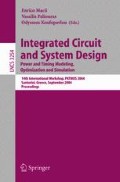Abstract
Leakage power consumption of current CMOS technology is already a great challenge. ITRS projects that leakage power consumption may come to dominate total chip power consumption as the technology feature size shrinks. We propose a novel leakage reduction technique, named “sleepy stack,” which can be applied to general logic design. Our sleepy stack approach retains exact logic state – making it better than traditional sleep and zigzag techniques – while saving leakage power consumption. Unlike the stack approach (which saves state), the sleepy stack approach can work well with dual-V th technologies, reducing leakage by several orders of magnitude over the stack approach in single-V th technology. Unfortunately, the sleepy stack approach does have a area penalty (roughly 50~120%) as compared to stack technology; nonetheless, the sleepy stack approach occupies a niche where state-saving and extra low leakage is desired at a (potentially small) cost in terms of increased delay and area.
Access this chapter
Tax calculation will be finalised at checkout
Purchases are for personal use only
Preview
Unable to display preview. Download preview PDF.
References
Kim, N.S., et al.: Leakage Current: Moore’s Law Meets Static Power. IEEE Computer 36(12), 68–75 (2003)
International Technology Roadmap for Semiconductors by Semiconductor Industry Association (2002), http://public.itrs.net
Clark, L.T., et al.: An Embedded 32-b Microprocessor Core for Low-Power and High-Performance Applications. IEEE Journal of Solid-State Circuits 36(11), 1599–1608 (2001)
Powell, M., Yang, S.-H., Falsafi, B., Roy, K., Vijaykumar, T.N.: Gated-Vdd: A Circuit Technique to Reduce Leakage in Deep-submicron Cache Memories. In: International Symposium on Low Power Electronics and Design, July 2000, pp. 90–95 (2000)
Mutoh, S., et al.: 1-V Power Supply High-speed Digital Circuit Technology with Multithreshold-Voltage CMOS. IEEE Journal of Solis-State Circuits 30(8), 847–854 (1995)
Chen, Z., Johnson, M., Wei, L., Roy, K.: Estimation of Standby Leakage Power in CMOS Circuits Considering Accurate Modeling of Transistor Stacks. In: International Symposium on Low Power Electronics and Design, pp. 239–244 (1998)
Narendra, S., Borkar, S., De, V., Antoniadis, D., Chandrakasan, A.: Scaling of Stack Effect and its Application for Leakage Reduction. In: International Symposium on Low Power Electronics and Design, August 2001, pp. 195–200 (2001)
Johnson, M., Somasekhar, D., Chiou, L.-Y., Roy, K.: Leakage Control with Efficient Use of Transistor Stacks in Single Threshold CMOS. IEEE Transactions on VLSI Systems 10(1), 1–5 (2002)
Min, K.-S., Kawaguchi, H., Sakurai, T.: Zigzag Super Cut-off CMOS (ZSCCMOS) Block Activation with Self-Adaptive Voltage Level Controller: An Alternative to Clock-gating Scheme in Leakage Dominant Era. In: IEEE International Solid-State Circuits Conference, February 2003, vol. 1, pp. 400–401 (2003)
Flautner, K., Kim, N.S., Martin, S., Blaauw, D., Mudge, T.: Drowsy Caches: Simple Techniques for Reducing Leakage Power. In: International Symposium on Computer Architecture, May 2002, pp. 148–157 (2002)
Avant! Corporation, http://www.avanticorp.com
Cadence Design Systems, http://www.cadence.com
NC State University Cadence Tool Information, http://www.cadence.ncsu.edu
Berkeley Predictive Technology Model (BPTM), http://www-device.eecs.berkeley.edu/~ptm/
Cao, Y., Sato, T., Sylvester, D., Orshansky, M., Hu, C.: New paradigm of predictive MOSFET and interconnect modeling for early circuit design. In: Proc. of IEEE CICC, June 2000, pp. 201–204 (2000)
Pfeiffenberger, P., Park, J., Mooney, V.: Some Layouts Using the Sleepy Stack Approach. Technical Report GIT-CC-04-05, Georgia Institute of Technology (June 2004), http://www.cc.gatech.edu/tech_reports/index.04.html
Author information
Authors and Affiliations
Editor information
Editors and Affiliations
Rights and permissions
Copyright information
© 2004 Springer-Verlag Berlin Heidelberg
About this paper
Cite this paper
Park, J.C., Mooney, V.J., Pfeiffenberger, P. (2004). Sleepy Stack Reduction of Leakage Power. In: Macii, E., Paliouras, V., Koufopavlou, O. (eds) Integrated Circuit and System Design. Power and Timing Modeling, Optimization and Simulation. PATMOS 2004. Lecture Notes in Computer Science, vol 3254. Springer, Berlin, Heidelberg. https://doi.org/10.1007/978-3-540-30205-6_17
Download citation
DOI: https://doi.org/10.1007/978-3-540-30205-6_17
Publisher Name: Springer, Berlin, Heidelberg
Print ISBN: 978-3-540-23095-3
Online ISBN: 978-3-540-30205-6
eBook Packages: Springer Book Archive

